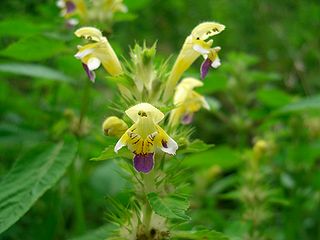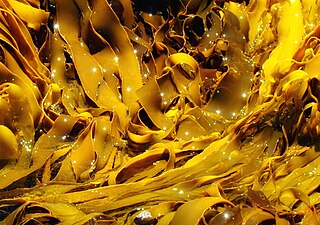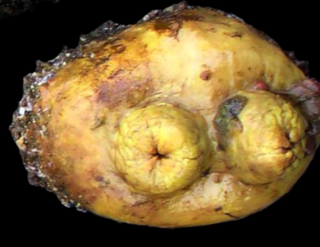
The order Lamiales are an order in the asterid group of dicotyledonous flowering plants. It includes about 23,810 species, 1,059 genera, and is divided into about 25 families. These families include Acanthaceae, Bignoniaceae, Byblidaceae, Calceolariaceae, Carlemanniaceae, Gesneriaceae, Lamiaceae, Lentibulariaceae, Linderniaceae, Martyniaceae, Mazaceae, Oleaceae, Orobanchaceae, Paulowniaceae, Pedaliaceae, Peltantheraceae, Phrymaceae, Plantaginaceae, Plocospermataceae, Schlegeliaceae, Scrophulariaceae, Stilbaceae, Tetrachondraceae, Thomandersiaceae, Verbenaceae.

Kelps are large brown algae or seaweeds that make up the order Laminariales. There are about 30 different genera. Despite its appearance, kelp is not a plant but a stramenopile, a group containing many protists.

Waders or shorebirds are birds of the order Charadriiformes commonly found wading along shorelines and mudflats in order to forage for food crawling or burrowing in the mud and sand, usually small arthropods such as aquatic insects or crustaceans. The term "wader" is used in Europe, while "shorebird" is used in North America, where "wader" may be used instead to refer to long-legged wading birds such as storks and herons.

Pyura is a large genus of sessile ascidians that live in coastal waters at depths of up to 80 m (260 feet). Like all ascidians, Pyura are filter feeders. A few species, including Pyura chilensis are commercially fished.

In biology, a species complex is a group of closely related organisms that are so similar in appearance and other features that the boundaries between them are often unclear. The taxa in the complex may be able to hybridize readily with each other, further blurring any distinctions. Terms that are sometimes used synonymously but have more precise meanings are cryptic species for two or more species hidden under one species name, sibling species for two species that are each other's closest relative, and species flock for a group of closely related species that live in the same habitat. As informal taxonomic ranks, species group, species aggregate, macrospecies, and superspecies are also in use.

The common galaxias or inanga is a very widespread Southern Hemisphere fish in the family Galaxiidae. It is a slim, narrow fish with a forked tail and a mottled, spotty pattern, typically about 10 cm (4 in) long when fully grown. It lives in fresh water, but spawns at river mouths and spends the first six months of its life at sea, returning en masse in spring. Its vernacular names include cowfish, jollytail, common jollytail, eel gudgeon, inaka, native trout, pulangi, puye, slippery tarki, spotted minnow, Falklands minnow and whitebait.

Duvaucel's gecko is a species of lizard in the family Diplodactylidae. The species is endemic to New Zealand and regarded as 'at risk' by the New Zealand Department of Conservation (DOC) due to distribution limitations.
In Australia, a cunjevoi may mean:

Beddomeia fultoni(B. fultoni) is a species of small freshwater snail belonging to the family Tateidae.
Beddomeia launcestonensis is a species of very small freshwater snail that has a gill and an operculum, an aquatic operculate gastropod mollusk in the family Hydrobiidae. This species is endemic to Australia.

Peringia ulvae, commonly known as the Laver spire shell or mudsnail, is a European species of very small aquatic snail with gills and an operculum, a gastropod mollusk in the family Hydrobiidae.

Pyura stolonifera, commonly known in South Africa as "red bait", is a sessile ascidian, or sea squirt, that lives in coastal waters attached to rocks or artificial structures. Sea squirts are named for their habit of squirting a stream of water from their exhalant siphons when touched at low tide.

Pyura praeputialis is an intertidal and shallow water species of tunicate. It is one of three species of "cunjevoi" in Australasia. It is the first reported species of marine organism to create a "foam-nest" for its larvae.

The biodiversity of Tasmania is of exceptional biological and paleoecological interest. A state of Australia, it is a large South Pacific archipelago of one large main island and a range of smaller islands. The terrain includes a variety of reefs, atolls, many small islands, and a variety of topographical and edaphic regions on the largest island, all of which promote the development of unusually concentrated biodiversity. During long periods geographically and genetically isolated, it is known for its unique flora and fauna. The region's climate is oceanic.

Pontohedyle is a genus of sea slugs, acochlidians, shell-less marine gastropod mollusks in the family Parhedylidae. Sea slugs in this genus are highly simplified and uniform.

Pyura pachydermatina is a sea tulip, a solitary species of tunicate in the suborder Stolidobranchia. It is native to shallow waters around New Zealand.

Pyura dalbyi, the yellow cunjevoi, is a species of tunicate
Hymenosoma is a genus of crabs, containing the following species:

Pyura herdmani, one of two southern African species of "red bait", is a sessile ascidian, or sea squirt, that lives in coastal waters attached to rocks or artificial structures. Sea squirts are named for their habit of squirting a stream of water from their exhalant siphons when touched at low tide.

Coscinasterias muricata is a species of starfish in the family Asteriidae. It is a large 11-armed starfish and occurs in shallow waters in the temperate western Indo-Pacific region.
















